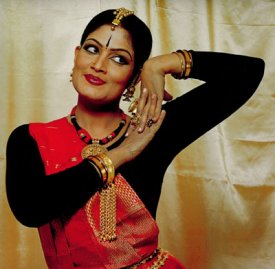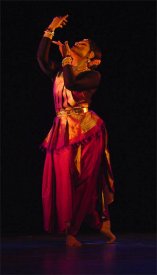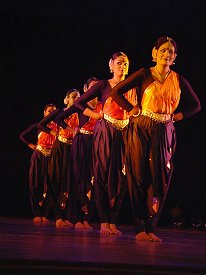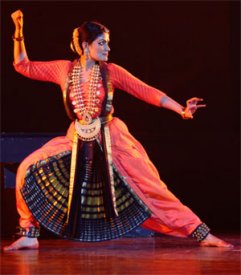
|
 |

|
 |
Geeta Chandran: New directions in dance - Lalitha Venkat, Chennai e-mail: lalvenkat@yahoo.com March 6, 2006  Among the well-known Bharatanatyam dancers of the new generation, Geeta Chandran was initiated in the art by guru Swarna Saraswathy in the Thanjavoor bani. Subsequently she was trained by Vazhuvoor V Sadasivam and Guru K N Dakshinamurthi. She has also pursued studies in abhinaya with gurus Jamuna Krishnan and Kalanidhi Narayanan. Since her arangetram in 1974, Geeta Chandran has grown into a mature performer with a distinctly creative mind. Blending tradition and innovation, she has experimented with issues and concerns of contemporary relevance in her dance. She is recognised not only for her deep and composite understanding of the art of Bharatanatyam, but also for her accomplishment as a Carnatic music vocalist, her work in television, video and film, theatre, choreography, dance-education and dance-issue journalism. An A-top graded artist, Geeta Chandran has performed in various parts of the country and abroad. She is the recipient of both the Junior and Senior Fellowships from the Department of Culture, Government of India for research in Bharatanatyam. She engages in a wide range of dance-related activities: performing, teaching, conducting, singing, collaborating, writing and speaking to new youth audiences. She is currently teaching Bharatanatyam at Natya-Vriksha, the institution she has founded in Delhi. Geeta has recently authored SO MANY JOURNEYS (a coffee-table book published by Niyogi Offset), an intensely personal collection of her writings narrating her engagement with classical dance.  When did you decide to move away from traditional Bharatanatyam and experiment with movement patterns and music? It was my late beloved Guru, K N Dakshinamurthi who urged me to experiment with adavus and jatis. This was in the early nineteen nineties. He insisted that the impulse that his late elder brother K N Dandayudhapani Pillai had in creating freshness to dance should be continued. So it was under his hawk eye that we started working different body patterns based on the broad framework of similar aesthetics. I remember him showing me off to Guru Mahalingam Pillai in Mumbai. Both of them chuckled at the immense possibilities and variations possible. Both traditionalists, they understood that the dance could evolve and yet engage. That generation was above narrow categorizations of dance and truly grasped what was beautiful and shaswath in dance. But they also realized that the dance had to evolve, grow and flourish. It is under their blessings that new directions in my dance blossomed. Do you think contemporary movement vocabulary/composition is more challenging than the classical Bharatanatyam you are trained in? I don't see the dichotomy. To me Bharatanatyam is an aesthetic flow that can meander with imagination. Arbitrary classifications like "contemporary" and "classical" are deeply misleading. There is only good dance and bad dance. Good dance is that which has intellectual integrity and is the organic response of a body seeped in training. Training the body is the key. With one look, one can know whether a dancer is well-trained or not. Beyond the training threshold, dance is an artistic, aesthetic, creative response. Do you think you evolve more as an artiste when you make forays into experimental work? Not at all. I can be as creative while essaying the impromptu abhinaya of a traditional varnam as I am when I am mapping various frontiers in ideas. The joys of creating remain the same. Sometimes I enjoy swimming purely within the pool. At other times, sometimes I dig deeper to excavate new patterns on its floor. And then sometimes I dig at the edges to change the shape of the pool itself. The joys of creating are the same. I evolve as an artist in all three activities. None is superior to the other. They are all equally valid. What was your motivation to write 'So Many Journeys'? So Many Journeys was a spring cleaning of sorts. I had so many memories of the learning process, of notes jotted on various scraps of paper, of memories stacked in my head. I wanted to put them together in one organized manner. I had written so many articles - some published, some returned, some never sent - all that was put together as a volume. It is different because it is my point of view. It is not the history of dance, but the experiences and thoughts of a dancer. I hope it opens a new generation of dance writing in India, not by scholars and of second-hand accounts of dance, but writings by the practitioners themselves of what they feel and what they are trying to say. Without filters. Do you find any difference in performing in north and south India? If I were to be scrupulously honest, then the best audience for dance in India today is in Delhi. It is cosmopolitan, truly interested and understanding of the creative process. Chennai's dance audiences are failing in dance literacy. Chennai has probably the best audience for craft dancing - or margam dancing. They need to be educated on dance as an art form. I hope that they will rise to that challenge too.  You have worked with puppets, multimedia, done programs on social issues…what are the challenges of this sort of work to hold the attention of the audience? My focus has been to enshrine dance in new spaces and find for it empowered spaces in the intellectual discourses of the day. I have worked at mainstreaming dance as part of various intellectual endeavours. Dance to me is not entertainment, but ideas. It is through ideas that I wish to appeal to audiences. Collaborations and partnerships are key to creativity today. Technology has to be befriended to enhance the aesthetic creative process. The key to collaborations are to match quality of the collaborating artists and to be seeped in the collaboration for some period of time when collaboration becomes meaningful. We have seen meaningful collaborations in musical jugalbandis just as we have seen un-meaningful musical collaborations. Recently, for the Chinmaya Mission, I put together Jai Bharati where eight top classical dancers came together to map saguna bhakti focusing on Krishna through the work of bhakti poets. Imagine an evening with Singhajit and Charu Mathur, Bharati Shivaji, Shovana Narayan, Madhavi Mudgal and Jayarama Rao and Vanashree. Yet, each of them came to the event with the utmost humility. Rehearsals and performances saw a high level of camaraderie. That was one kind of fulfilling collaboration. I have worked with visual artists like Arpana Caur, Shuvaprasanna and Paresh Maity. They have been involved closely with my creative process. The performance emerged as artistic dialogues. I have worked with filmmakers like Anasuya Vaidya and Vandana Kohli. They have understood my stance as an artist and have reacted in film accordingly. I work with costume designers like Sandhya Raman or Anjana Bhargav. They bring their training and sensitivity to my persona. So collaborations are beautiful. They enable bridges to be built and new scapes to be architectured. As a creative artist the next frontier is the most exciting, isn't it? Do you think in today's dance scenario, glamour and marketing oneself is integral to being seen on the circuit? Marketing is possible only when the product is marketable. You cannot sell any dud. But if the product is stable and attractive, then marketing can propel it to public eye. I am a communicator. I can dance, but I also speak, sing, choreograph, compose, write, discuss and argue. That is my personality. I have worked hard at all of them. Why should I be apologetic for any of my strengths?  Because of proliferation of dancers, do you think it is necessary to diversify into contemporary work to be in the rat race? I welcome the proliferation of dancers; it is testimony to the intrinsic worth of the classical experience. But how many are able to sustain themselves as performing artists? Dance is a cruel profession; extremely demanding and, quite frankly, does not pay enough. How can we encourage our youth to take dancing professionally, when we know that their path will be fraught with financial insecurities? But, proliferation of artists and dancers cannot be justification for diversifying into contemporary work. The motivation for that change has to come from within one's conviction and thought processes and creative juices. External factors cannot catalyze the change. It has to come from deep within. For me the challenge is to create anew using the technique of the tradition. That is opening of new vistas. Wings with roots. Because without roots, wings will get you nowhere…. Today's shows are getting glitzy and hi-tech. Does this visual aid help in covering up lack of talent / enhance production value / necessary part of modern day productions where visual element is vital…your comment. Everything around us is getting glitzy and high-tech. Our homes are high tech, our weddings have become glitzy, even birthday parties and dinner parties have become "events.' This environment also impacts the performance and the way it is presented. But let us be aware that audiences are not fools. If an artist uses tech and glitz to cover up lack of true performance value, the audiences will stay away. These maneuvers may bring audiences in for the first couple of times, but the true value of an artist is in the art, not the add-ons. You have said, "The dancer and the dance have no commercial value." Could you please elaborate? In today's macro commercialised environment, everything is forced to join the marketplace. All the other arts have products that can be separated from the creator: artists have their paintings and sculptures, musicians their CDs and tapes, architects their drawings, writers and playwrights their books and volumes, etc. It is only the dancer and the theatre performer (whom Bharata combined in his Natya Shastra) who do not have a product for their art separate from their own person. The dancer creates the moment with the body, as does the theatre actor. These are the most vulnerable of the arts since they can never join the marketplace and so need to be offered other kinds of protection and promotion. The marketplace will never salute dance because there is no product independent of the dancer's person; a video of dance is not dance; it is the product of the filmmaker or videographer's craft. It will always be Satyajit Ray's film on Bala; the film is not Bala; it can never be! It is always Avinash Pasricha's photo of Geeta Chandran; but it is not Geeta. Contact: geetachandran@hotmail.com |